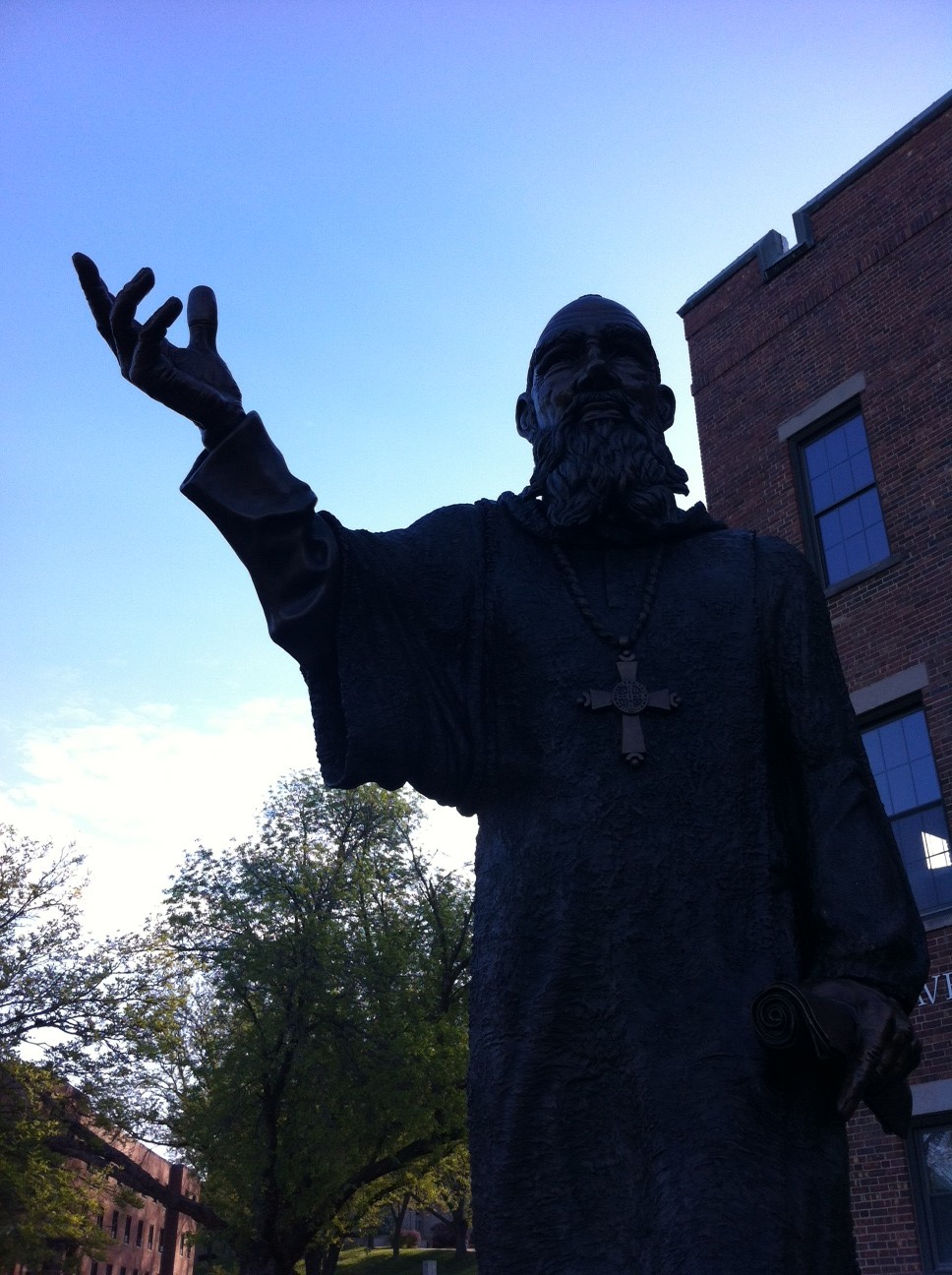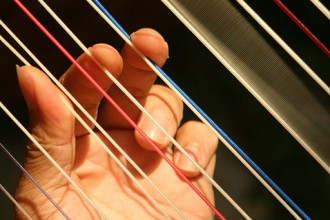
I’m coming to you from St Benedict’s Abbey in Atchison, Kansas, and I’d like to speak a word on behalf of utilitarian art.
As I walk around the grounds of the Abbey, which is also home to Benedictine College, I see a bronze statue of St Benedict outside the student union. Benedict reaches outwards and upwards with his right hand, inviting the student body to go out and do great things for Christ. This hand is the hand of one of the former abbots of the monastery, which the sculptor used as a model for Benedict’s hand. The use of the abbot’s hand for the statue of St Benedict brings Benedict closer to home, and makes him seem like a more recent father for all the students, staff and faculty of the college.
I also notice, as I join in the Liturgy of the Hours in the abbey church, that a large number of the psalm chants are marked by the initials “BKS”, for Fr. Blaine Schultz, the Abbey Choirmaster. Fr. Blaine has written a large amount of the liturgical music that the monastic community sings. This music was specifically written for this particular group of monks on the banks of the Missouri River. There is something encouraging about knowing that you are singing music written by one of your brothers to help you worship God better, a brother with whom you eat, pray, and work every day.
As I exit the abbey church, I pass underneath a giant mural that covers the wall at one end of the monastic choir. This mural depicts Christ’s crucifixion in red and white, with a golden Father watching over the scene and reaching out with arms to embrace, and a white Dove connecting the two. On either side of Christ are angels in blue and purple, carrying the instruments of crucifixion, as well as the chalice of the Last Supper. Christ is flanked by St Benedict and his sister St Scholastica, standing watch in full habit with abbatial croziers. In the four corners of the image are scenes of monks in black – two of monks being blessed by St Benedict as they work (wrapping cloth and carrying rocks, it seems), and two of monks serving others (by anointing the sick, and what looks like shoeing a horse). This mural connects the work and lives of the monastery’s monks to the work of Christ on the cross, offering themselves to – and being embraced by – God the Father. It is an image which connects the monks to their tradition, and encourages them to continue the work that their brothers, following Christ according to the model of St Benedict.
None of this art is meant to be a vehicle for the artist’s self-expression. It is all meant to point the viewer (or singer) to God, such that the artist fades into invisibility. It is also meant to connect the viewer (or singer) to his or her brothers and sisters in Christ, especially those who share their monastic commitment. This art finds its value in service, in utility – in the work of charity it accomplishes. Yet it remains beautiful. Indeed, without its purpose, it would lose much of its beauty, which comes not only from its appearance or sound, but from the love for God and others which shines through it.
Think of this post as a public service announcement: We often deride utilitarian works of art as derivative, unoriginal, and mediocre – not true Art. But the power of monastic art to connect us to God and each other should give us pause, and cause us to question the dogma that that Art is best which refuses to serve.
Cole Matson is a second-year PhD student in the Institute for Theology, Imagination & the Arts, researching the Eucharist as a model for communion-building in the theatre. He is the Guest Contributions Editor for Transpositions.
__________________
Image credit: Author





Thanks, Cole, for this interesting post! I think you are right to challenge this either/or perspective when it comes to utilitarian art. While you mentioned that the work is not meant to be a vehicle for the artist’s self-expression with artist fading into invisibility, what contribution do you think the artist makes in this situation?
I think that art can’t help but express the artist to an extent. However, that’s different than creating art for the purpose of self-expression. I think of one autobiographical solo show I saw a colleague perform. At the end of the show, I felt I understood the person better, but I also felt like I had spent $20 to watch someone’s primal scream therapy session. I didn’t feel that the art served the audience, but rather served the artist – that it was therapeutic for them to express themselves. Which is fine, but then why charge me $20 to perform the service of listening to you?
That’s perhaps an example of self-expression cloaked under another form, under the assumption that seeing an artist express him- or herself is always beneficial to the audience. However, honest self-expression can be good for the audience. For example, if there was an audience member present at that solo show whose life experience was similar, but who thought they were alone, they could have been greatly encouraged to find someone else with a similar experience. If the artist believes something strongly, and feels they must express that belief, it could help encourage others who share the same belief to be more vocal about it. However, in that case, I hope that people are expressing that belief in service of a particular cause or person/people, not just because it’s their own belief, and other people must therefore know about it. I think art is most powerful when it is created in service of a third thing/idea/person, which is neither the artist nor the audience, and helps bring both artist and audience together closer to that third thing.
But more directly related to your question, I think, first, that of course the artist makes the contribution of creating the art. The artwork couldn’t do any of the things I mention in the post without the artist to create it. So the artist is obviously vital. I think the artworks I wrote about also express their artists’ love for God and their communities. I think, by creating the artwork, the artist does do a work of charity for others, by helping them to follow God and be connected to each other, but humbly, without drawing attention to him- or herself. In the case of these works specifically, drawing attention to the artist would distract from the purpose of the work, and lessen its power.
Thanks Cole- I too agree there is a false dichotomy between “utilitarian art” and…well, “self-expressive art” (to put it in the context of this essay- is that a fair way to put it?).
I have come to believe that all art is, in some way “utilitarian,” (maybe I got this from Wolterstorff) and that all art is paradoxically self-expression and not about self-expression at all (which maybe I got from merging Sayers, Chesterton, and Sol LeWitt).
As an artist brought up in craft (MFA Ceramics) it’s a particularly interesting issue for me. I was also thinking about other art objects that are part of the liturgy, say, the chalice and patten. How are they both utilitarian and art?
David,
As hinted in my comment to Sara above, I absolutely agree with you that art is both utilitarian, in that it does an action and serves some purpose (of which the purpose of self-expression is an example), and also expresses the artist in some way, even if indirectly and without the artist’s intent. I also think it best expresses the artist when it serves the values/people/Person the artist serves, not when it serves the artist him/herself, just as, according to Christianity, we are most ourselves, most alive, when we die to ourselves.
Re: the chalice and paten, for example, they clearly serve a particular purpose in the liturgy, that of holding the Body and Blood. Their design can also be both beautiful and practical. For example, a paten can be shaped in such a way that it’s easier to wipe the crumbs off of it and into the chalice. A chalice with a wider base, and a large knob in the center of the stem, is less likely to tip over and is easier to hold without dropping. These practical concerns are often merged with artistic embellishment, so you see large jewels or stones being placed in the stem’s knob (which actually can further improve the grip), or the base of the chalice being extended out into four “roots” which both ground it and can provide a space for carvings of the Four Evangelists to be displayed, one on each “root”. So the utility provides opportunities for art, and the art takes up the utility and brings glory to that purpose.
The choice of material can also say different things. For example, we might make a chalice out of gold or silver in order to say that we love God enough that we want to give Him the best and most valuable of what we have, and/or to image forth the Kingdom as a place of splendour, a heavenly court where we the Church are gathered to praise our King. Or, we might make a chalice of wood, stone, or clay, in order to say that God loves the poor and treasures them above silver or gold, and/or to provide a vision of the Kingdom as the place where the least will become first, a Gospel of love and humility which is for those who are not valued by the economy of this world.
But either type of material can show the beauty of God. It can show brightness, attractiveness, splendour, claritas. It can show the spiritual beauty of humility. (And even the idea of spiritual beauty relies on our experience of seeing physical beauty for the metaphor to work.) But the purpose, the utility, and the artistic choices merge beautifully.